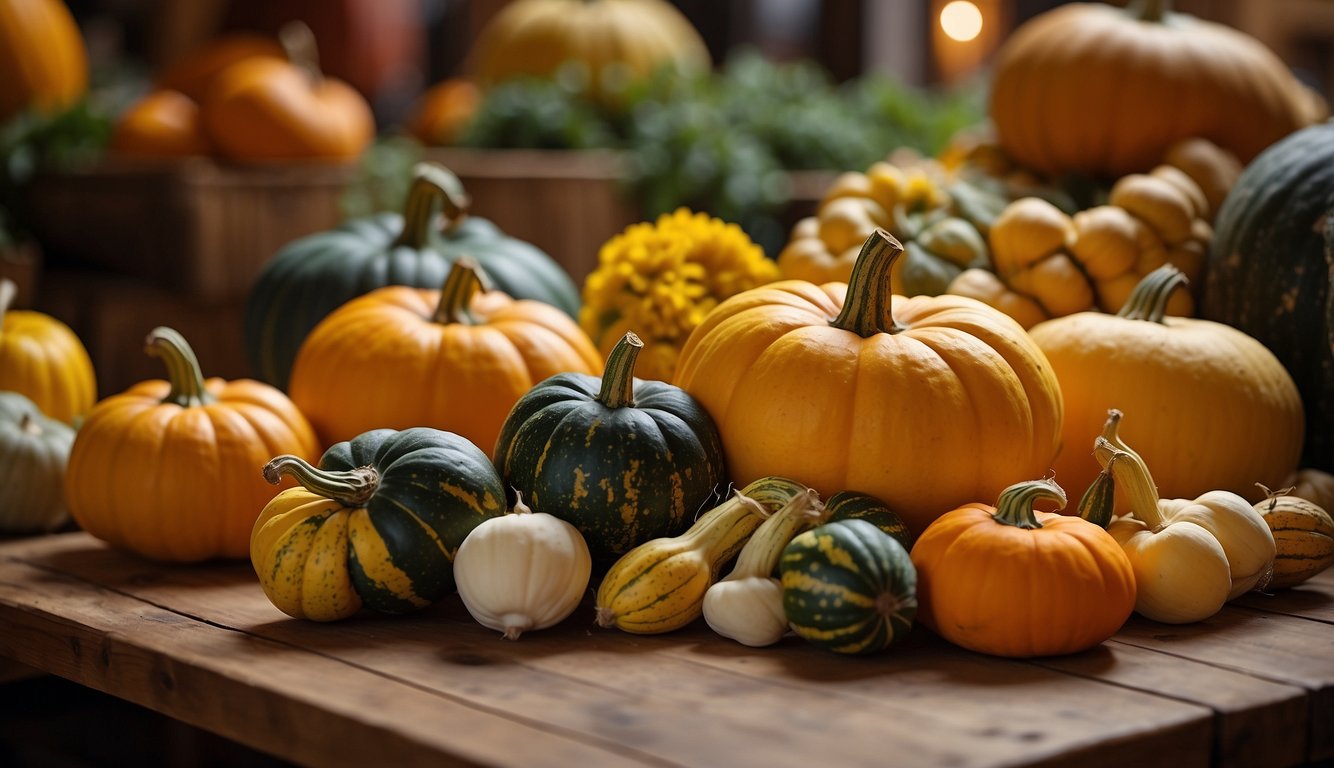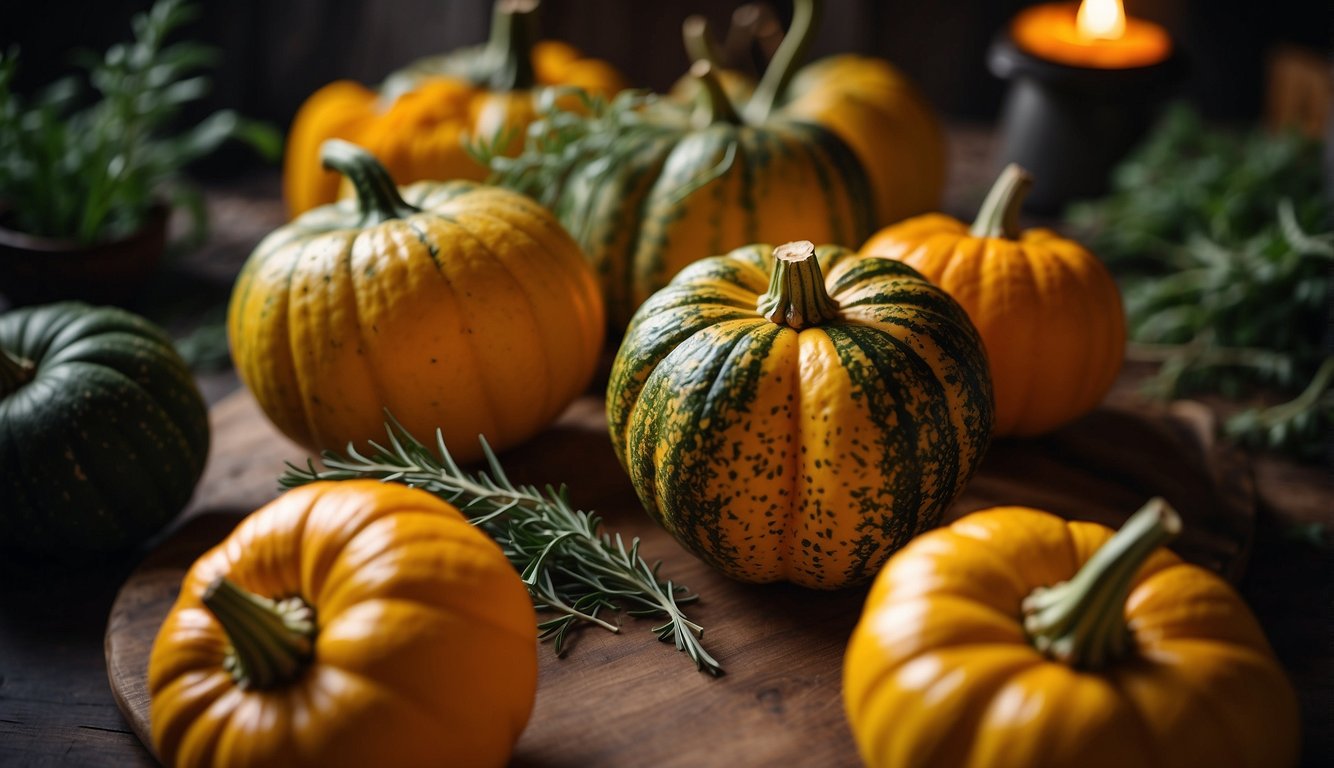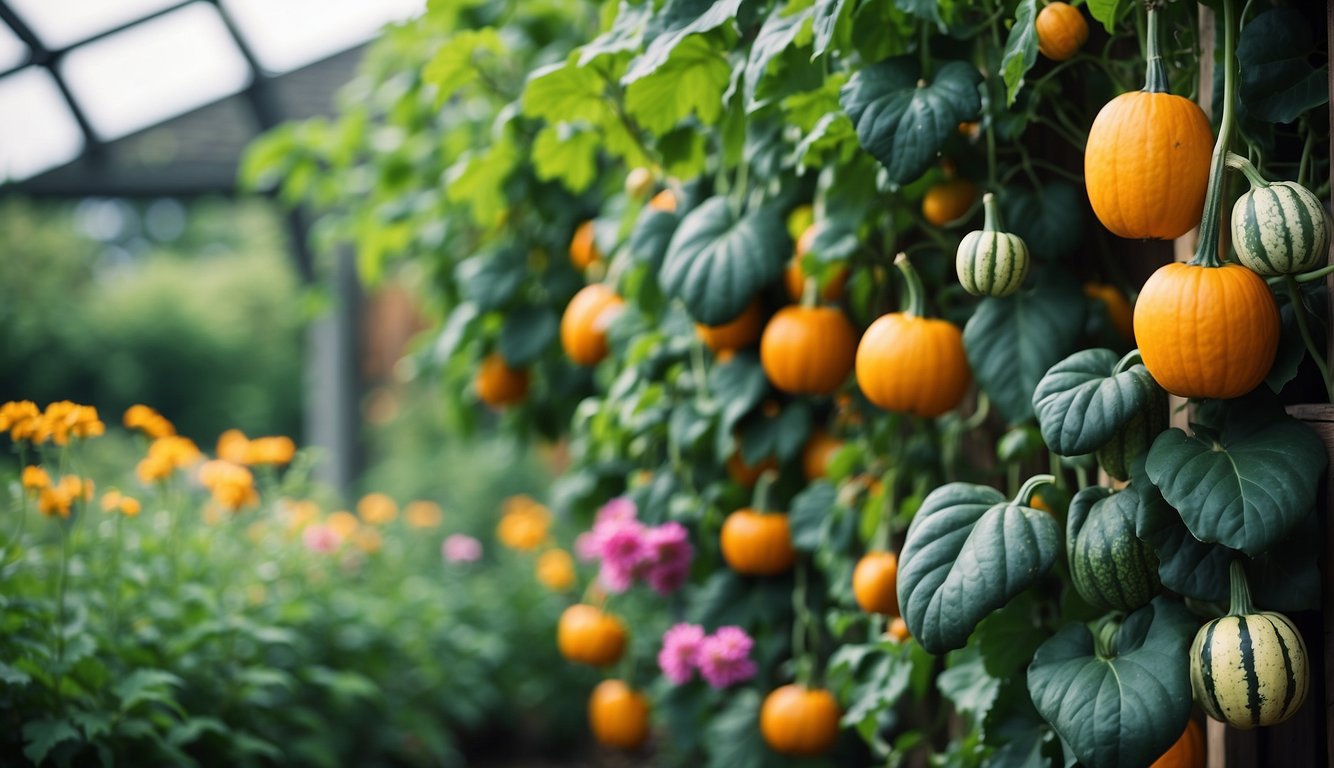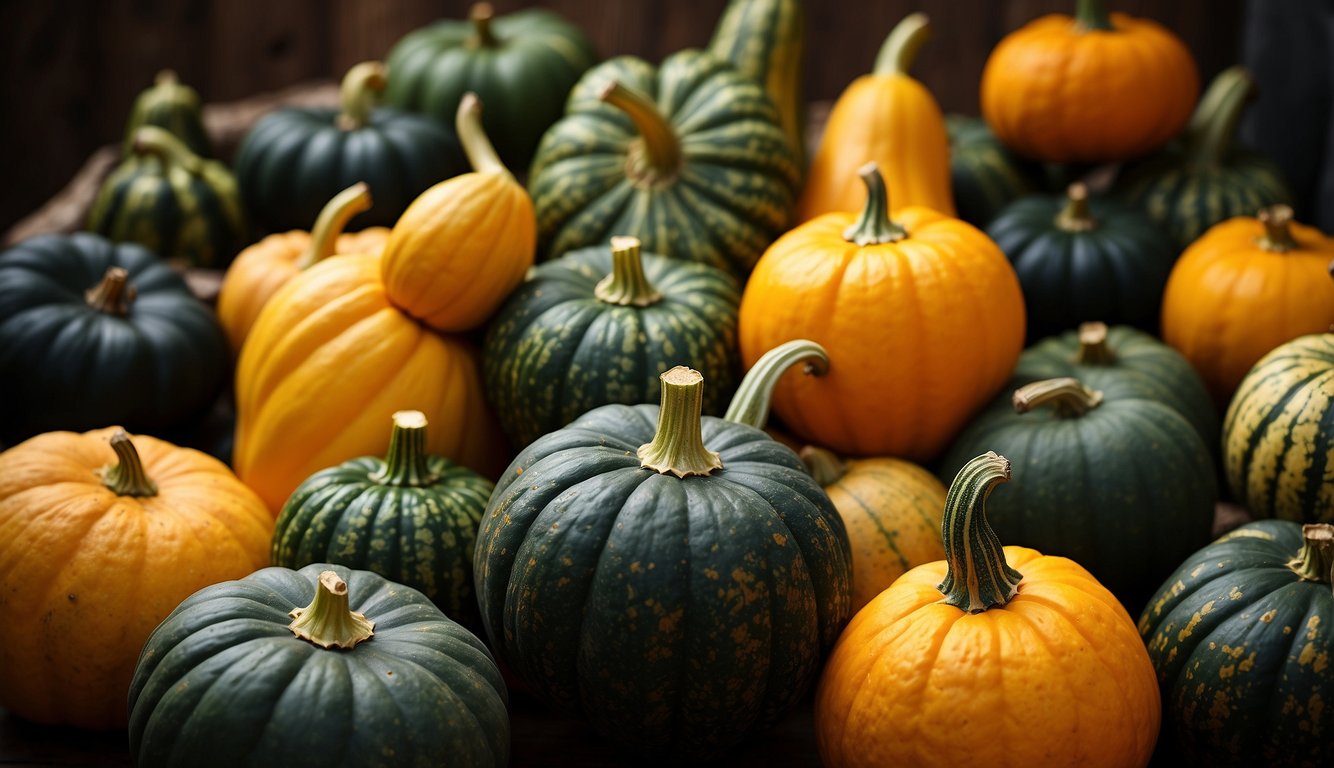TheHerbProf.com is a treasure trove of knowledge for those interested in natural healing and herbal remedies. The website is run by Paul Johnston MD. A naturopathic who has not only received extensive education in the field but also has personal experience in self-healing.
Winter squash is a versatile and nutritious vegetable that comes in many different varieties.
From the classic butternut squash to the lesser-known delicata squash, there are plenty of options to choose from.
As someone who loves cooking with winter squash, I have tried many different varieties and have found some favorites that I always come back to.
One of my top picks for winter squash is the butternut squash. This variety is easy to find in most grocery stores and has a sweet, nutty flavor that pairs well with a variety of dishes.
It also has a smooth, creamy texture that makes it perfect for soups, stews, and purees.
Another great option is the acorn squash, which has a slightly nutty flavor and a tender, slightly sweet flesh.
It’s also a good source of vitamin C, potassium, and fiber, making it a healthy choice for any meal.
Understanding Winter Squash
Winter squash is a type of vegetable that is harvested in the fall and winter months.
It is an excellent source of vitamins and fiber, making it a great addition to any diet.
Winter squash comes in many different varieties, each with its own unique flavor and texture.
Types of Winter Squash
There are many different types of winter squash, including butternut, acorn, spaghetti, and hubbard.
Butternut squash is one of the most popular varieties and has a sweet, nutty flavor. It has a smooth, tan exterior and bright orange flesh.
Acorn squash is another popular variety and has a dark green exterior with distinctive green stripes. It has a slightly sweet flavor and is perfect for roasting or baking.
Spaghetti squash is a unique variety that has a stringy, spaghetti-like texture when cooked. It is often used as a low-carb alternative to pasta and has a mild, nutty flavor.
Hubbard squash is a large, teardrop-shaped variety with a bumpy exterior and yellow flesh. It has a sweet, nutty flavor and is perfect for pies, soups, and roasting.
Nutritional Profile
Winter squash is an excellent source of vitamins and fiber.
It is particularly high in vitamin A, which is important for eye health and immune function.
Winter squash also contains antioxidants, which can help protect against chronic diseases.
Additionally, it is a good source of fiber, which can help promote digestive health and keep you feeling full.
Cultivation and Harvest

Winter squash is a great addition to any garden. It is easy to grow and can produce an abundant harvest. In this section, I will discuss the cultivation and harvest of winter squash.
Growing Season and Conditions
Winter squash requires a long growing season, typically between 80 to 120 days to maturity.
It is best to plant winter squash seeds in late spring or early summer, when the soil is warm and the danger of frost has passed.
Winter squash prefers well-drained soil that is rich in organic matter.
It is important to keep the soil moist but not waterlogged. Adding a layer of mulch around the plants can help retain moisture and control weeds.
Harvesting Techniques
Winter squash is ready to harvest when the fruit has matured and the skin has hardened. The stem should be dry and brown.
To harvest, cut the fruit from the vine using a sharp knife or pruning shears. Be sure to leave a few inches of stem attached to the fruit.
After harvesting, it is important to cure the squash.
Curing allows the fruit to develop a hard skin and improves its flavor and storage life.
To cure, place the squash in a warm, dry location for 7 to 10 days.
Pests and Diseases
Winter squash can be susceptible to pests and diseases, such as powdery mildew, squash vine borers, and cucumber beetles.
To prevent these problems, it is important to practice good garden hygiene, such as removing plant debris and rotating crops.
If pests or diseases do occur, there are several organic options for control.
For example, planting resistant varieties or using row covers can help prevent squash vine borers. Neem oil or insecticidal soap can be used to control cucumber beetles.
Varietal Highlights

As a winter squash enthusiast, I have tried and tested many different varieties of this delicious vegetable. Here are some of the highlights:
Delicata Squash
Delicata squash, also known as sweet potato squash, has a creamy texture and a sweet, nutty flavor.
It is one of the smaller winter squash varieties, making it perfect for stuffing and roasting. I love to slice it into rings and roast it with a little olive oil and sea salt.
Butternut Squash
Butternut squash is one of the most popular winter squash varieties, and for good reason. It has a smooth, creamy texture and a sweet, slightly nutty flavor.
It is perfect for roasting, pureeing, and using in soups and stews. I love to make butternut squash soup with a little bit of cream and a sprinkle of nutmeg.
Acorn Squash
Acorn squash is a small, green winter squash with a ribbed exterior and a sweet, nutty flavor.
It is perfect for stuffing and roasting, and can also be pureed and used in soups and stews. I love to stuff acorn squash with a mixture of quinoa, kale, and roasted chickpeas.
Spaghetti Squash
Spaghetti squash gets its name from its stringy, spaghetti-like flesh. It has a mild, slightly sweet flavor and is perfect for use in place of pasta in dishes like spaghetti squash carbonara or spaghetti squash primavera.
Kabocha Squash
Kabocha squash, also known as Japanese pumpkin, has a sweet, nutty flavor and a creamy texture.
It is perfect for roasting, pureeing, and using in soups and stews. I love to roast kabocha squash with a little bit of soy sauce and sesame oil.
Hubbard Squash
Hubbard squash is a large, blue-grey winter squash with a sweet, nutty flavor and a dry, mealy texture.
It is perfect for roasting and pureeing, and can also be used in soups and stews. I love to make a Hubbard squash pie with a little bit of cinnamon and nutmeg.
Preparing and Cooking

As someone who loves winter squash, I find that the best way to prepare it depends on the variety of squash and my personal preferences. Here are a few ways I like to prepare and cook winter squash.
Roasting and Pureeing
Roasting is a great way to bring out the sweet and mild taste of winter squash.
To roast winter squash, I cut it in half and seed it. Then, I rub the flesh with softened butter or oil, season with salt and pepper, and drizzle with brown sugar, maple syrup, or orange juice.
I roast the squash halves, cut-side up, on a rimmed baking sheet in a preheated 400 degrees F (200 C) oven for 40 to 45 minutes until they are tender and caramelized.
After roasting, I scoop out the flesh and puree it in a blender or food processor until it has a creamy texture.
This puree can be used in soups, pies, or as a side dish.
Winter Squash in Soups and Pies
Winter squash is a great ingredient to use in soups and pies.
To use it in soups, I like to roast the squash first, then add it to the soup with some broth, onions, and garlic.
I let it simmer until the flavors have melded together, then I puree the soup until it has a smooth and creamy texture.
Winter squash soup is perfect for a cozy night in or as a starter for a holiday meal.
When it comes to pies, I prefer to use pureed winter squash instead of canned pumpkin.
The puree has a creamier texture and a sweeter taste.
To make a winter squash pie, I mix the puree with eggs, cream, sugar, and spices, then pour it into a prepared pie crust.
I bake it in a preheated 350 degrees F (175 C) oven for 50 to 60 minutes until the filling is set and the crust is golden brown.
Storage and Preservation

As winter squash can last for several months, proper storage and preservation techniques are essential to ensure that they stay fresh and flavorful for as long as possible. Here are some tips on how to store and preserve winter squash:
Curing Winter Squash
Curing is the process of allowing the squash to sit in a warm, dry place for a week or two after harvesting.
This allows the skin to harden and the squash to develop a longer shelf life.
To cure winter squash, place them in a warm, dry area with good air ventilation, such as a garage or porch.
Make sure to turn them regularly to ensure that all sides get enough air and sunlight.
Ideally, the temperature should be between 75 and 85 degrees Fahrenheit (24 to 29 degrees Celsius) with a relative humidity of 50 to 70 percent.
Storing Techniques
Once the squash has been cured, it is ready for storage.
The ideal temperature for storing winter squash is between 50 and 55 degrees Fahrenheit (10 to 13 degrees Celsius), with a relative humidity of 50 to 70 percent.
Too much humidity can cause the squash to rot, while too little can cause them to dry out and lose flavor.
Here are some tips on how to store winter squash:
- Store cured squash on a shelf or rack, not on the floor.
- Keep the skins of cured squash dry to prevent the growth of fungi and bacteria.
- Inspect the squash regularly for signs of rot or decay, and remove any damaged squash immediately.
- Do not store winter squash near ethylene-producing fruits and vegetables, such as apples, bananas, and tomatoes, as this can cause them to ripen and spoil more quickly.
Selecting the Right Variety

As a winter squash enthusiast, I’ve tried growing and cooking with many varieties over the years. I’ve found that selecting the right variety can make all the difference in both the yield of your garden and the taste of your dishes. Here are my recommendations for selecting the right winter squash variety.
For the Home Gardener
If you’re planning to grow your own winter squash, consider the space you have available and the length of your growing season.
Some varieties, like the Blue Hubbard, can grow to be quite large and require ample space to thrive. Others, like the delicata squash, are smaller and can be grown in a container garden.
For the home gardener, I recommend trying heirloom varieties like the Boston Marrow or the Rouge Vif d’Etampes.
These varieties are easy to grow and are known for their excellent flavor. Additionally, they can often be stored for several months after harvest, making them a great option for those who want to enjoy their harvest well into the winter months.
For Culinary Use
When it comes to selecting a winter squash variety for culinary use, it’s important to consider the texture and flavor of the squash.
Some varieties, like the butternut squash, have a smooth texture and a sweet, nutty flavor that makes them a great choice for soups and stews.
Other varieties, like the kabocha squash, have a denser texture and a slightly nutty flavor that makes them a great choice for roasting or baking.
If you’re looking for a versatile winter squash that can be used in a variety of dishes, I recommend trying the acorn squash.
This variety has a slightly sweet, nutty flavor and a tender texture that makes it a great choice for roasting, baking, or even grilling. Additionally, it’s a great source of vitamins A and C, making it a nutritious addition to any meal.
Gardening Tips

As a seasoned gardener, I have learned a few tips and tricks for growing winter squash that I would love to share with you. Winter squash is a vine plant that produces edible fruits that are harvested in the fall. Here are some tips on how to grow winter squash successfully.
Soil and Fertilizer
Winter squash plants thrive in rich, well-draining soil. Before planting, I like to amend the soil with plenty of compost and organic matter to ensure that the plants have all the nutrients they need to grow healthy and strong.
If you plan to grow only a few plants, use 2 to 3 tablespoons of a balanced (10-10-10) fertilizer for each hill. Scatter the fertilizer evenly over a 2-foot by 2-foot area. Work it into the top 3 to 4 inches of soil.
Or, for a larger garden area, add 2 to 3 pounds of balanced fertilizer for each 100 square feet.
Trellising and Pruning
Winter squash plants are vigorous growers and can take up a lot of garden space. To save space, you can trellis your winter squash plants. This also helps to keep the fruits off the ground, which can prevent rot and disease.
When trellising, make sure to use a sturdy support system that can handle the weight of the vines and fruits.
Pruning is also important for winter squash plants. I like to prune the side shoots and leaves that are growing too close to the ground.
This allows for better air circulation and can prevent fungal diseases. Additionally, pruning can help redirect the plant’s energy towards producing more fruits instead of growing more foliage.
Mulch
Mulching is a great way to keep the soil moist and suppress weed growth around your winter squash plants.
I like to use organic mulch such as straw or leaves. Make sure to apply a layer of mulch around the base of the plants, but keep it a few inches away from the stem to prevent rot.
Best Winter Squash: A Herbalist’s Perspective
Today, we’re going to dive into a topic that’s as hearty as the squash in our gardens – Best Winter Squash.
Now, you might be wondering, what’s so special about winter squash? Well, it’s simple. Winter squash is hardy, nutritious, and delicious. It’s the perfect vegetable to grow during the colder months!
But here’s the fun part – winter squash doesn’t just add variety to your meals. It also benefits the soil. By improving soil health, it creates a nurturing environment for your herbs to grow.
Now, let’s connect this back to our home page, theherbprof.com. Our website is all about celebrating the magic of herbs and exploring the wonderful world of herbalism. And guess what? By understanding the benefits of growing winter squash, you’re contributing to this world in your own unique way.
So, next time you’re planning your winter garden, remember to plant some winter squash. Not just for their hearty goodness, but also for their benefits to the soil. After all, a happy garden is a garden where all life forms live in harmony.
References – Best Winter Squash
Little Herb Encyclopedia, by Jack Ritchason; N.D., Woodland Publishing Incorporated, 1995
The Ultimate Healing System, Course Manual, Copyright 1985, Don Lepore
Planetary Herbology, Michael Tierra, C.A., N.D., Lotus Press, 1988
Handbook of Medicinal Herbs, by James A. Duke, Pub. CRP Second Edition 2007
The Complete Medicinal Herbal, by Penelope Ody, Published by Dorling Kindersley
Check the Following Articles!
Neem Oil Plants: Benefits, Uses, and Application Guide
Black Soldier Fly Compost: How to Make and Use It
What Do Growing Brussel Sprouts Look Like?
Easy Potato Growing: Tips for a Bountiful Harvest
Frequently Asked Questions – Best Winter Squash
What are the top varieties of winter squash for flavor?
In my experience, the top winter squash varieties for flavor are Butternut, Acorn, and Delicata. These three varieties have a sweet and nutty flavor that is perfect for roasting and baking.
Which winter squash recipes are considered the best?
There are countless winter squash recipes out there, but some of the most popular include roasted butternut squash soup, acorn squash stuffed with quinoa, and delicata squash roasted with maple syrup and cinnamon. These recipes are all delicious and easy to make, making them perfect for a cozy winter meal.
How does kabocha squash compare to other winter squashes in taste and texture?
Kabocha squash, also known as Japanese pumpkin, has a sweet and nutty flavor that is similar to butternut squash. However, it has a denser texture and a slightly drier flesh. Kabocha squash is great for roasting and baking, and it is often used in Japanese cuisine.
What are the best methods for storing winter squash long-term?
Winter squash can be stored for several months if stored properly. The best way to store winter squash is in a cool, dry place with good ventilation. Avoid storing squash near fruits that produce ethylene gas, such as apples and bananas, as this can cause the squash to spoil more quickly.
Which winter squash variety is most suitable for roasting?
In my opinion, the best winter squash variety for roasting is Butternut squash. Its sweet and nutty flavor becomes even more pronounced when roasted, and its flesh becomes tender and caramelized. Acorn squash and Delicata squash are also great for roasting.
What is the sweetest variety of winter squash available?
The sweetest variety of winter squash available is the Sugar Pie pumpkin. This variety of pumpkin is smaller than other pumpkin varieties and has a sweeter, less fibrous flesh.
It is often used in baking and making pumpkin pies.


